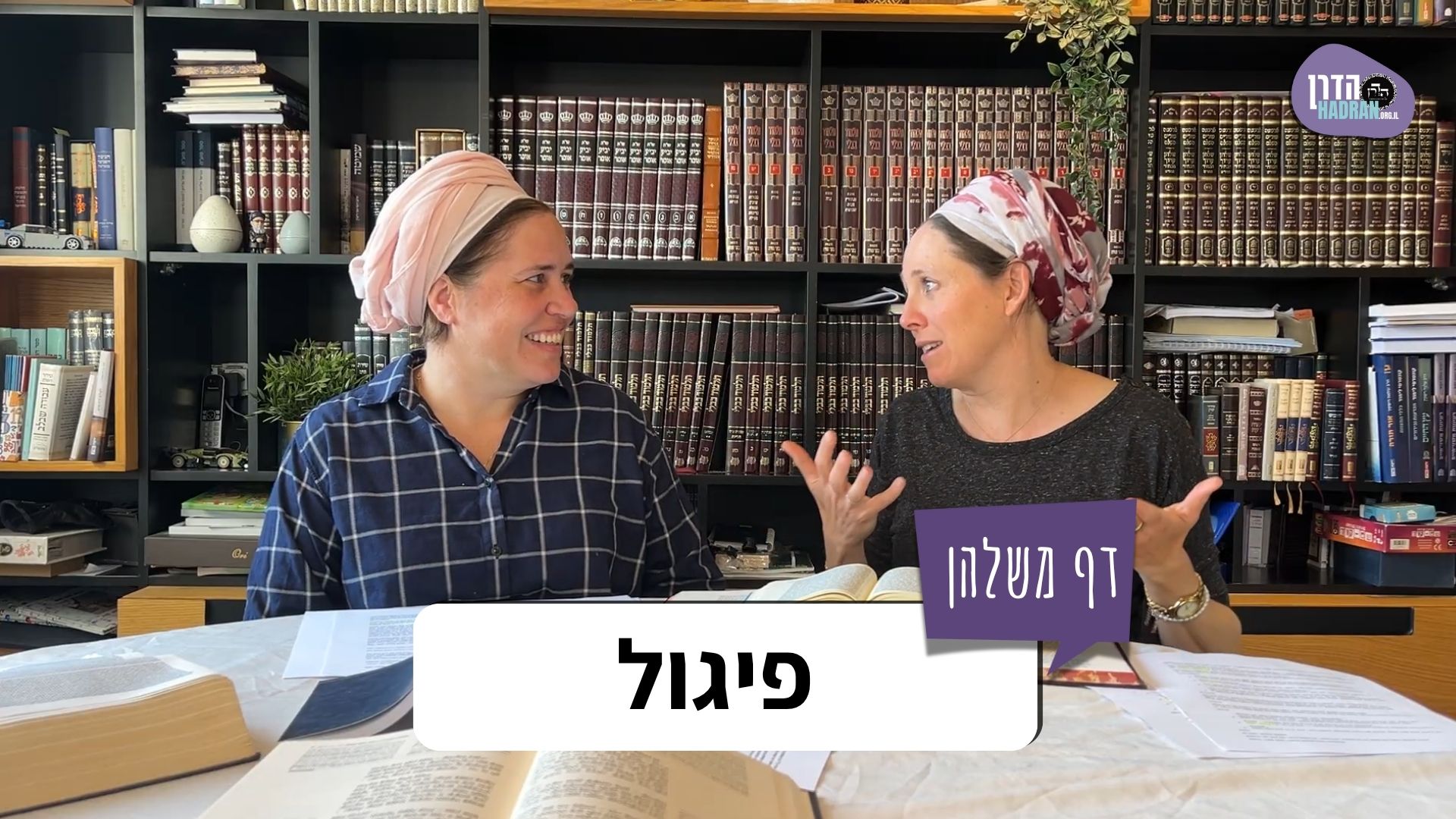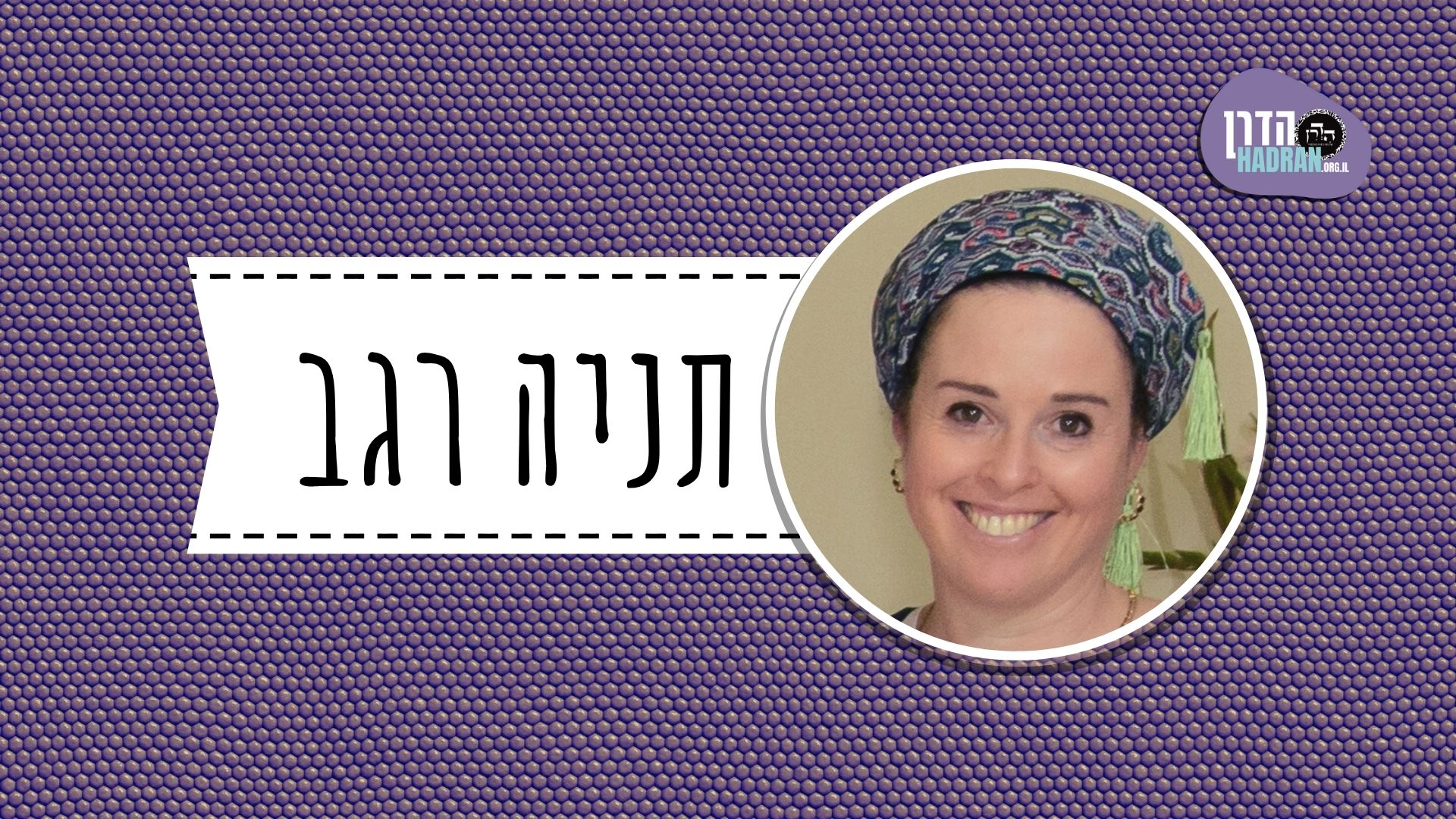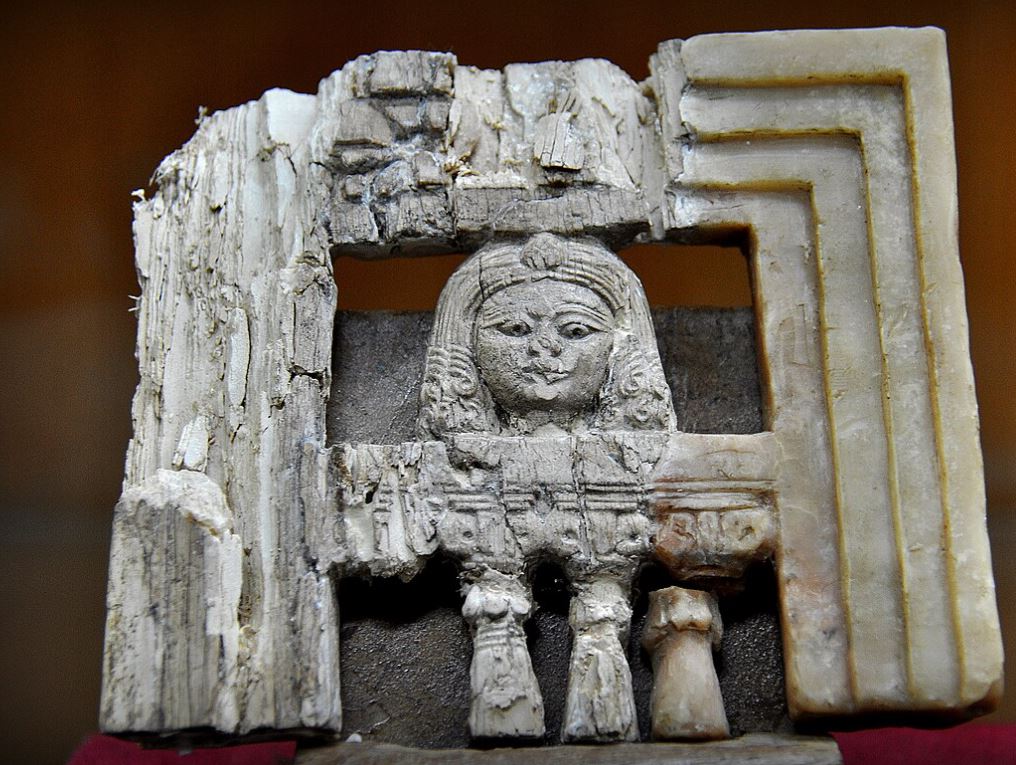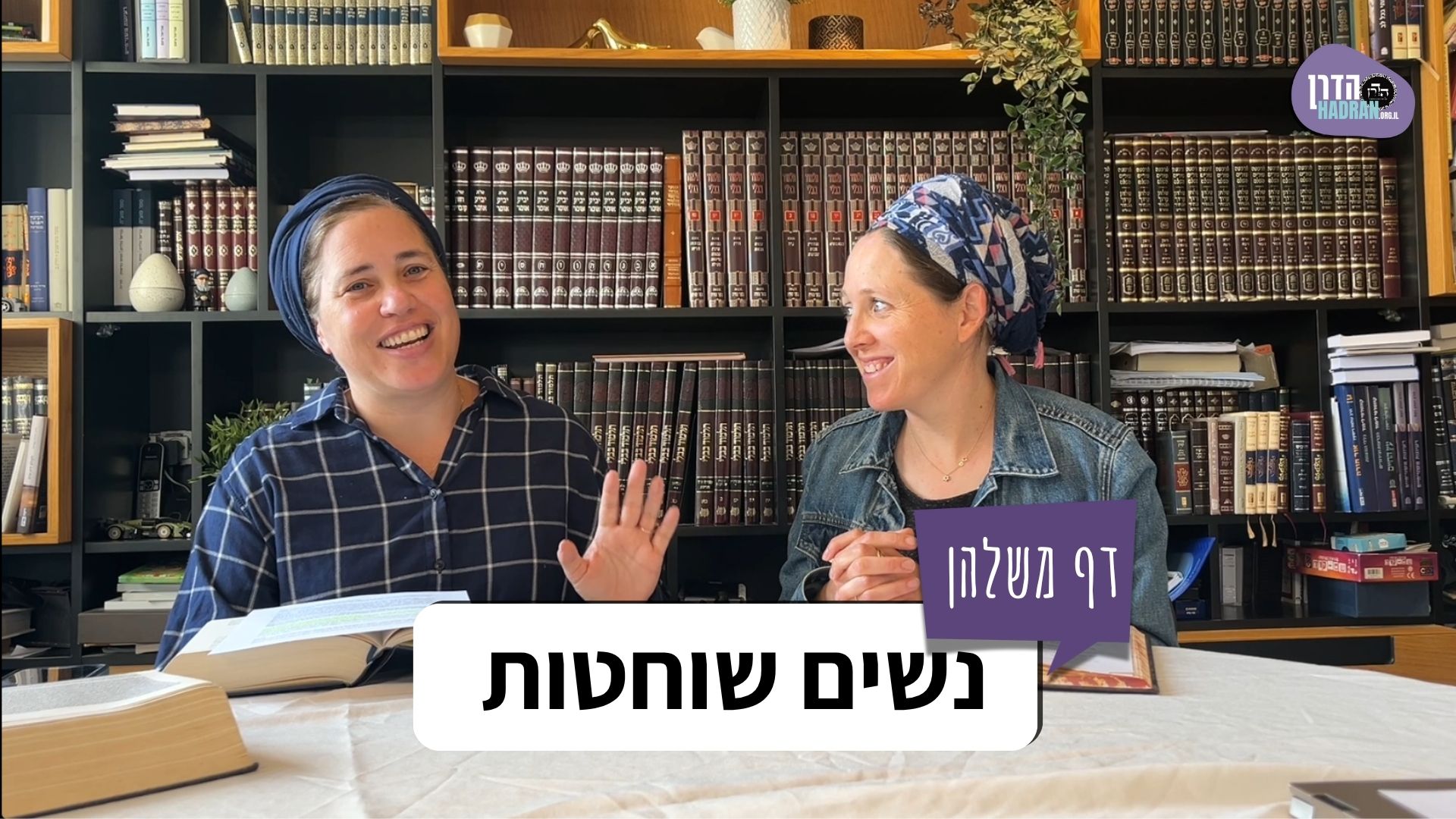מסיימים את הרשימה של מומים ודאיים ועוברים לרשימות של מומים של ספק – אסור להקריב אבל לא מותרים לשחוט. מהן? הגמרא פוטרת סתירות בין מה שמופיע במשנה שבחלק מהמקרים נשמעים כמו מומים שמוזכרים בתורה כמומים ודאיים. טומטום ואנדרוגינוס – יש שלוש דעות לגבי מה הסטטוס שלהם – ספק, ודאי זכר או ודאי אינו יכול להיות בכור.
לימוד החודש מוקדש ע”י בט בלקני לכבוד נכדתה, דבורה חנה סרח אייכל.
רוצים להקדיש למידה? התחל כאן:

לימוד החודש מוקדש ע”י בט בלקני לכבוד נכדתה, דבורה חנה סרח אייכל.
העמקה
רוצה להבין מה באמת קורה מתחת לפני השטח של הסוגיה?
שיעורים, פודקאסטים והרחבות של מיטב המורות שלנו יפתחו לך עוד זוויות וכיווני חשיבה.
חדשה בלימוד הגמרא?
זה הדף הראשון שלך? איזו התרגשות עצומה! יש לנו בדיוק את התכנים והכלים שיעזרו לך לעשות את הצעדים הראשונים ללמידה בקצב וברמה שלך, כך תוכלי להרגיש בנוח גם בתוך הסוגיות המורכבות ומאתגרות.
פסיפס הלומדות שלנו
גלי את קהילת הלומדות שלנו, מגוון נשים, רקעים וסיפורים. כולן חלק מתנועה ומסע מרגש ועוצמתי.
בכורות מא
גְּמָ׳ תָּנָא: קֶפֶץ הָעֶלְיוֹן וְלֹא קֶפֶץ הַתַּחְתּוֹן, וּכְנֶגְדּוֹ בְּגָמָל נִיכָּר.
GEMARA: With regard to the case in the mishna of the tail of a calf that does not reach the leg joint, it is taught in a baraita: This leg joint is the upper joint, between the thighbone and the tibia, and not the lower joint, between the middle and lower bones. And with regard to this upper joint, the corresponding bone in the leg of a camel is conspicuous, but in a calf it is not noticeable from the outside.
מַתְנִי׳ עַל אֵלּוּ מוּמִין שׁוֹחֲטִין אֶת הַבְּכוֹר, וּפְסוּלֵי הַמּוּקְדָּשִׁין נִפְדִּין עֲלֵיהֶן.
MISHNA: For these blemishes enumerated in the previous mishnayot, one slaughters the firstborn outside the Temple and disqualified consecrated animals may be redeemed on their account.
גְּמָ׳ הָא תּוּ לְמָה לִי? הָא תְּנָא לֵיהּ רֵישָׁא: עַל אֵלּוּ מוּמִין שׁוֹחֲטִין אֶת הַבְּכוֹר! סֵיפָא אִיצְטְרִיכָא: פְּסוּלֵי הַמּוּקְדָּשִׁין נִפְדִּין עֲלֵיהֶן. הָא נָמֵי פְּשִׁיטָא — מִישְׁחָט שָׁחֲטִינַן, מִיפְרָק מִיבַּעְיָא?
GEMARA: The Gemara asks: Why do I need this additional statement that for these blemishes one slaughters the firstborn outside the Temple? It was already taught in the first clause, at the beginning of the chapter: For these blemishes, one may slaughter the firstborn animal outside the Temple. The Gemara answers that the latter clause of the mishna was necessary: Disqualified consecrated animals may be redeemed due to these blemishes. The Gemara asks: But this too is obvious; if one may slaughter a firstborn due to these blemishes, is it necessary to state that one may redeem them?
אֶלָּא, אַיְּידֵי דִּתְנָא שְׁלֹשָׁה הוֹסִיף, וְאָמְרוּ לוֹ: לֹא שָׁמַעְנוּ אֶת אֵלּוּ, וְקָתָנֵי וְאָתֵי דִּיחִידָאָה, וְקָא סָתֵים לַהּ בְּכוּלְּהוּ: עַל אֵלּוּ מוּמִין שׁוֹחֲטִין אֶת הַבְּכוֹר וּפְסוּלֵי הַמּוּקְדָּשִׁין נִפְדִּין עֲלֵיהֶן.
Rather, since a previous mishna taught that Ila added three additional blemishes, and the Sages said to him: We did not hear about those, and then the tanna of the mishna proceeded to teach halakhot in the name of individual opinions, those of Rabbi Ḥananya ben Gamliel and Rabbi Ḥanina ben Antigonus, one might have thought that the halakha is not in accordance with their rulings. Therefore, he states an unattributed ruling in this mishna with regard to all their statements: For all these blemishes enumerated in the previous mishnayot, one slaughters the firstborn, and disqualified consecrated animals may be redeemed due to them. This indicates that the halakha is in accordance with all of these individual opinions.
מַתְנִי׳ וְאֵלּוּ שֶׁאֵין שׁוֹחֲטִין עֲלֵיהֶן, לֹא בַּמִּקְדָּשׁ וְלֹא בַּמְּדִינָה: חֲוַורְוָר, וְהַמַּיִם שֶׁאֵין קְבוּעִין, וְחוּטִין הַפְּנִימִיּוֹת שֶׁנִּפְגְּמוּ — אֲבָל לֹא שֶׁנֶּעֶקְרוּ, וּבַעַל גָּרָב, וּבַעַל יַבֶּלֶת, וּבַעַל חֲזָזִית, זָקֵן, וְחוֹלֶה, וּמְזוֹהָם, וְשֶׁנֶּעֶבְדָה בּוֹ עֲבֵירָה, וְשֶׁהֵמִית אָדָם — עַל פִּי עֵד אֶחָד אוֹ עַל פִּי הַבְּעָלִים.
MISHNA: And these are the blemishes that one does not slaughter the firstborn due to them, neither in the Temple nor in the rest of the country: Pale spots on the eye and tears streaming from the eye that are not constant; and internal gums that were damaged but that were not extracted; and an animal with boils that are moist inside and out [garav]; and an animal with warts; and an animal with boils [ḥazazit]; and an old or sick animal, or one with a foul odor; and one with which a transgression was performed, e.g., it copulated with a person or was the object of bestiality; and one that killed a person. In these latter two cases, the act of bestiality or killing became known on the basis of the testimony of one witness or on the basis of the owner.
וְטוּמְטוּם וְאַנְדְּרוֹגִינוֹס, לֹא בַּמִּקְדָּשׁ וְלֹא בַּמְּדִינָה. רַבִּי שִׁמְעוֹן אוֹמֵר: אֵין לְךָ מוּם גָּדוֹל מִזֶּה, וַחֲכָמִים אוֹמְרִים: אֵינוֹ בְּכוֹר, אֶלָּא נִגְזָז וְנֶעֱבָד.
And one does not slaughter a tumtum, whose sexual organs are concealed, and a hermaphrodite [ve’anderoginos], which has both male and female sexual organs, neither in the Temple nor in the rest of the country. Rabbi Shimon says: You have no blemish greater than that, and it may be slaughtered. And the Rabbis say: The halakhic status of a hermaphrodite is not that of a firstborn; rather, its halakhic status is that of a non-sacred animal that may be shorn and utilized for labor.
גְּמָ׳ וְגָרָב לָא? וְהָכְתִיב ״גָּרָב״ בְּאוֹרָיְיתָא! וַחֲזָזִית לָא? וְהָכְתִיב ״יַלֶּפֶת״ בְּאוֹרָיְיתָא! וְתַנְיָא: ״גָּרָב״ — זֶה הַחֶרֶס, ״יַלֶּפֶת״ — זוֹ חֲזָזִית הַמִּצְרִית, וְאָמַר רֵישׁ לָקִישׁ: לָמָּה נִקְרָא שְׁמָהּ ״יַלֶּפֶת״? שֶׁמְּלַפֶּפֶת וְהוֹלֶכֶת עַד יוֹם הַמִּיתָה.
GEMARA: The mishna teaches that the two types of boils: Garav and ḥazazit, are not considered full-fledged blemishes for which one may slaughter a firstborn outside the Temple. The Gemara asks: And is garav not considered a blemish? But isn’t it written “garav” in the Torah, in the list of blemishes (see Leviticus 22:22)? And furthermore, is ḥazazit not considered a blemish? But isn’t it written “yalefet” in the Torah, in the same verse, and it is taught in a baraita: “Garav”; this is referring to boils that are hard as earthenware [ḥeres]; “yalefet”; this is the ḥazazit that affected the Egyptians (see Exodus 9:10). And Reish Lakish says: Why is it called yalefet? The reason is that it grabs [melapefet] continuously onto an invalid until the day of death, i.e., it cannot be healed.
בִּשְׁלָמָא חֲזָזִית אַחֲזָזִית לָא קַשְׁיָא: כָּאן בַּחֲזָזִית הַמִּצְרִית, כָּאן בַּחֲזָזִית דְּעָלְמָא. אֶלָּא גָּרָב אַגָּרָב קַשְׁיָא! גָּרָב אַגָּרָב נָמֵי לָא קַשְׁיָא, הָא בְּלַח, הָא בְּיָבֵשׁ. לַח — אִיתַּסִּי, יָבֵשׁ — לָא מִיתַּסֵּי.
Granted, the contradiction between the status of the ḥazazit mentioned in the Torah and that of the ḥazazit in the mishna is not difficult, as here the Torah is referring to an Egyptian ḥazazit, and there the mishna is referring to a regular ḥazazit. But the contradiction between the status of the garav listed in the Torah and the garav of the mishna is difficult. The Gemara answers that the contradiction between the garav in the Torah and the garav in the mishna is also not difficult: This ruling of the mishna is referring to moist boils, whereas that garav of the Torah is referring to dry boils. Moist boils will heal and therefore are considered a temporary blemish for which one may not slaughter a firstborn; dry ones will not heal.
וְלַח מִיתַּסֵּי? וְהָכְתִיב: ״יַכְּכָה ה׳ בִּשְׁחִין מִצְרַיִם וְגוֹ׳״, וּמִדִּכְתִיב ״וּבְחֶרֶס״ הֲרֵי גָּרָב לַח אָמוּר, וְקָאָמַר: ״אֲשֶׁר לֹא תוּכַל לְהֵרָפֵא״!
The Gemara asks: And does a moist boil heal? But isn’t it written: “The Lord will smite you with the boil of Egypt, and with the hemorrhoids, and with garav, and with ḥares, from which you cannot be healed” (Deuteronomy 28:27). And since it is written: “And with ḥares,” which is referring to boils that are as hard as earthenware [ḥeres], moist garav is thereby stated, and with regard to both types that verse states: “From which you cannot be healed.”
אֶלָּא, תְּלָתָא הֲווֹ: דִּקְרָא — יָבֵשׁ בֵּין מִבִּפְנִים בֵּין מִבַּחוּץ, דְּמַתְנִיתִין — לַח מִבַּחוּץ וּמִבִּפְנִים, דְּמִצְרַיִם — יָבֵשׁ מִבִּפְנִים וְלַח מִבַּחוּץ, דִּכְתִיב ״וַיְהִי שְׁחִין פּוֹרֵחַ אֲבַעְבּוּעוֹת בָּאָדָם״.
Rather, there are three types of garav: First, the garav of the verse that deals with blemishes, which is dry both on the inside and on the outside. This cannot be healed, and it is called ḥares in Deuteronomy. The second is the garav of the mishna, which can be healed, and is moist on the outside and inside. Third, the garav of Egypt, mentioned in Deuteronomy as one of the types of boils of Egypt. This garav is dry on the inside and therefore cannot be healed, but it is moist on the outside, as it is written with regard to the plague of boils in Egypt: “And it became a boil breaking forth with avabu’ot upon man and upon animal” (Exodus 9:10). Avabu’ot is referring to a substance that pours out [nove’a] and is moist.
וְהַזָּקֵן וְהַחוֹלֶה וְהַמְזוֹהָם. מְנָהָנֵי מִילֵּי? דְּתָנוּ רַבָּנַן: ״מִן הַצֹּאן וּמִן הַכְּשָׂבִים וּמִן הָעִזִּים״ — פְּרָט לַזָּקֵן וְלַחוֹלֶה וְלַמְזוֹהָם.
§ Among the conditions that are not considered full-fledged blemishes, but one may not sacrifice an animal with one such condition as an offering either, the mishna lists: And an old animal, or a sick animal, or one with a foul odor. The Gemara asks: From where are these matters derived? They are derived from a verse, as the Sages taught: The verse states: “And if his offering be from [min] the flock, whether from the sheep or from the goats” (Leviticus 1:10). These three instances of the word “from [min]” serve to exclude the old, and the sick, and the animal with a foul odor, which may not be sacrificed.
וּצְרִיכִי, דְּאִי כְּתַב רַחֲמָנָא לְמַעוֹטֵי זָקֵן, דְּלָא הָדַר בָּרֵיא, אֲבָל חוֹלֶה, דַּהֲדַר בָּרֵיא — אֵימָא לָא. וְאִי כְּתַב לְמַעוֹטֵי חוֹלֶה, דְּלָאו אוֹרְחֵיהּ, אֲבָל זָקֵן, דְּהַיְינוּ אוֹרְחֵיהּ — אֵימָא לָא.
The Gemara notes: And all three exclusions are necessary. As, had the Merciful One written the word “from” once, one might have said that this serves to exclude an old animal, which will not become healthy again, as it will never get younger. But with regard to a sick animal, which might become healthy again, say that it is not disqualified. And, alternatively, had the Merciful One written only one term of exclusion, one might have said that it serves to exclude a sick animal, as it is not the natural manner of an animal to be sick. But with regard to an old animal, as this is the natural manner of all animals to grow old, say that it should not be disqualified from the altar.
וְאִי כְּתַב רַחֲמָנָא תְּרֵי, לְמַעוֹטֵי הָנֵי דִּכְחִישִׁי, אֲבָל מְזוֹהָם דְּלָא כְּחִישׁ — אֵימָא לָא, וְאִי נָמֵי לְמַעוֹטֵי מְזוֹהָם מִשּׁוּם דִּמְאִיס, אֲבָל הָנֵי דְּלָא מְאִיסִי — אֵימָא לָא, צְרִיכִי.
And had the Merciful One written only two terms of exclusion, one might have said that they serve to exclude these weak animals, the sick and the old, as one should sacrifice only a fat, healthy animal. But with regard to an animal with a foul odor, which is not weak, say that it should not be disqualified. And alternatively, had there been only one term of exclusion, one might have said that it serves to exclude an animal with a foul odor, as it is repulsive. But with regard to these other two cases of an old and a sick animal, which are not repulsive, say that they are not excluded. Therefore, all three exclusions are necessary.
וְשֶׁנֶּעֶבְדָה בּוֹ עֲבֵירָה וְכוּ׳. מְנָא הָנֵי מִילֵּי?
§ The mishna teaches: And an animal with which a transgression was performed, and one that killed a person that was known on the basis of the testimony of one witness or the owner, are disqualified from being sacrificed. The Gemara asks: From where are these matters derived?
דְּתָנוּ רַבָּנַן: ״מִן הַבְּהֵמָה״ — לְהוֹצִיא רוֹבֵעַ וְנִרְבָּע, ״מִן הַבָּקָר״ — לְהוֹצִיא אֶת הַנֶּעֱבָד, ״מִן הַצֹּאן״ — לְהוֹצִיא אֶת הַמּוּקְצֶה, ״וּמִן הַצֹּאן״ — לְהוֹצִיא אֶת הַנּוֹגֵחַ.
They are derived from a verse, as the Sages taught in a baraita that when the verse states: “You shall bring your offering from the cattle, even from the herd or from the flock” (Leviticus 1:2), each mention of the word “from” is interpreted as a term of exclusion. The expression “from the cattle” serves to exclude an animal that copulated with a person and an animal that was the object of bestiality. The expression “from the herd” serves to exclude an animal worshipped as a deity, and “from the flock” serves to exclude an animal set aside for idol worship. Finally, the word “or” in the expression “or from the flock” serves to exclude an animal that gored and killed a person.
הָנֵי בְּנֵי קְטָלָא נִינְהוּ! עַל פִּי עֵד אֶחָד אוֹ עַל פִּי הַבְּעָלִים.
The Gemara challenges: In these cases of an animal that copulated with a person, an animal that was the subject of bestiality, and an animal that gored and killed a person, they are liable to death by stoning. Why, then, is a verse necessary to exclude them? The Gemara answers that this is referring to a case where the incident was known on the basis of the testimony of one witness or on the basis of the owner. Therefore, the animal is not killed, as there are not two witnesses to the event, but the testimony is sufficient to disqualify the animal as a sacrifice.
בִּשְׁלָמָא טוּמְטוּם, בַּמִּקְדָּשׁ לָא — דִּילְמָא נְקֵבָה הִיא, בַּמְּדִינָה לָא — דִּילְמָא זָכָר הוּא וְלֵית בֵּהּ מוּמָא.
§ The mishna teaches that one does not slaughter a tumtum and a hermaphrodite, neither in the Temple nor in the rest of the country. The Gemara asks: Granted, one does not slaughter a tumtum, neither in the Temple, as perhaps it is a female and therefore does not have firstborn status and may not be sacrificed, nor in the rest of the country, as perhaps it is a male and it does not have a blemish, in which case he would be slaughtering a sacrificial animal.
אֶלָּא אַנְדְּרוֹגִינוֹס, בִּשְׁלָמָא בַּמִּקְדָּשׁ לָא, דִּלְמָא נְקֵבָה הִיא. אֶלָּא בַּמְּדִינָה נָמֵי, נְהִי דְּזָכָר הוּא — תֵּעָשֶׂה נַקְבוּת חָרִיץ, וְיִשְׁחוֹט עָלֶהָ!
But in the case of a hermaphrodite, granted that one does not slaughter it in the Temple, as perhaps it is a female. But with regard to the rest of the country, even let it be considered a male; nevertheless, its female sex organ should be considered as a crack [ḥaritz], which is included in the blemish of “cracked” [ḥarutz] listed in the Torah (Leviticus 22:22), and let one slaughter it due to that blemish.
אָמַר אַבָּיֵי: אָמַר קְרָא ״אוֹ חָרוּץ אוֹ שָׁבוּר״, חָרוּץ דּוּמְיָא דְּשָׁבוּר, מָה שָׁבוּר בִּמְקוֹם עֶצֶם, אַף חָרוּץ בִּמְקוֹם עֶצֶם.
Abaye said in response: The verse states: “Or cracked or broken” (Leviticus 22:22), which teaches that the blemish of being cracked is similar to that of being broken: Just as the blemish of being broken is relevant in the location of a bone, as there is no break where there is only flesh, so too, the term cracked is referring to a blemish found in the location of a bone, not in the location of the sex organs.
רָבָא אָמַר: בְּלָא שָׁבוּר נָמֵי לָא מָצֵית אָמְרַתְּ חָרוּץ בִּמְקוֹם בָּשָׂר הָוֵי מוּמָא, דְּאִי סָלְקָא דַעְתָּךְ הָוֵי מוּמָא, כֵּיוָן דְּאָמַר ״גָּרָב״ זֶהוּ חֶרֶס, מִיחְרָץ חֲרִיץ, דִּכְתִיב: ״וּמַרְאֵהוּ עָמוֹק מִן הָעוֹר״, כְּמַרְאֵה חַמָּה הָעֲמוּקָּה מִן הַצֵּל.
Rava said: Even without the comparison to “broken,” you cannot say that a crack in the location of flesh, where there is no bone, is a blemish. As, if it would enter your mind that it is a blemish, since the tanna of the baraita cited above said with regard to “garav” that this is referring to boils that are hard as earthenware [ḥeres], evidently this blemish is a crack in the skin, as it is written with regard to the skin disease of leprosy: “And its appearance is deeper than the skin” (Leviticus 13:30), and the Sages explained: It is similar to the appearance of an area lit by the sun that seems deeper than the shade, which appears to cover it.
וְלִיכְתֹּב רַחֲמָנָא ״חָרוּץ״ וְלָא בָּעֵי ״גָּרָב״, וְאָמֵינָא: ״חָרוּץ״ דְּלָא מְאִיס — הָוֵי מוּמָא, ״גָּרָב״ דִּמְאִיס — לֹא כׇּל שֶׁכֵּן? כְּתַב רַחֲמָנָא ״גָּרָב״ לְמֵימַר דְּחָרוּץ בִּמְקוֹם בָּשָׂר — לָא הָוֵי מוּמָא.
And if so, let the Merciful One write: Crack, and it would not need to state garav, and I would say: If being cracked, which is not repulsive, is a blemish, then with regard to garav, which is repulsive, should it not all the more so be considered a blemish? Therefore, the Merciful One writes garav, to say that a crack found in the location of flesh is not a blemish. Consequently, one cannot say that the female sex organ of a hermaphrodite should be considered a blemish for which one may slaughter a firstborn outside the Temple.
רַבִּי יִשְׁמָעֵאל אוֹמֵר: אֵין לְךָ מוּם גָּדוֹל מִזֶּה. כְּאַבָּיֵי לָא אָמַר, חָרוּץ דּוּמְיָא דְּשָׁבוּר לָא אָמְרִינַן.
In this connection, the Gemara cites the statement of the mishna with regard to a hermaphrodite: Rabbi Yishmael says: You have no blemish greater than that, and it may be slaughtered. Evidently, Rabbi Yishmael maintains that the female sex organ of a hermaphrodite is considered a blemish. The Gemara explains: Rabbi Yishmael does not state a ruling like that of Abaye, as he maintains that we do not say that the blemish of being cracked is similar to that of being broken. Rather, they are entirely different blemishes, and a crack found on flesh is considered a blemish.
כְּרָבָא נָמֵי לָא אָמַר, דִּילְמָא הֵיכָא דְּלָא מִינַּכְרָא, אֲבָל הֵיכָא דְּמִינְּכַר — ״מוּם רָע״ קָרֵינָא בֵּיהּ.
Rabbi Yishmael also does not state a ruling like that of Rava, as perhaps his conclusion that a crack found where there is no bone is not a blemish applies only in a case where it is not conspicuous. But in a case where it is conspicuous, such as the female sex organ, we call it “an ill blemish” (Deuteronomy 15:21), and the animal is disqualified for use as an offering.
בָּעֵי רָבָא: מַאי טַעְמָא דְּרַבִּי יִשְׁמָעֵאל? מִיפְשָׁט פְּשִׁיטָא לֵיהּ אַנְדְּרוֹגִינוֹס בְּכוֹר הוּא וּמוּמוֹ עִמּוֹ, אוֹ דִילְמָא סַפּוֹקֵי מְסַפְּקָא לֵיהּ, וְ״אִם תִּימְצָא לוֹמַר״ קָאָמַר — אִם תִּימְצָא לוֹמַר בְּכוֹר הוּא, הֲרֵי מוּמוֹ עִמּוֹ!
Rava raises a dilemma: What is the reason of Rabbi Yishmael that a hermaphrodite is definitely blemished? Is it obvious to him that a hermaphrodite animal is a male that has firstborn status, and it comes with its blemish, i.e., the female sex organ, and therefore it is permitted to slaughter it outside the Temple? Or perhaps Rabbi Yishmael is uncertain whether or not a hermaphrodite is considered a male, and he says his ruling in the manner of: If you say. In other words, if you say that a hermaphrodite animal is a firstborn, it comes with its blemish, and it may be slaughtered outside the Temple.
לְמַאי נָפְקָא מִינַּהּ? לְמִילְקֵא עֲלֵיהּ מִשּׁוּם גִּיזָּה וַעֲבוֹדָה, אִי נָמֵי לְמִיתְּבֵהּ לְכֹהֵן.
The Gemara asks: What is the practical difference between the reasons? The Gemara answers that there is a difference with regard to being flogged on account of this animal due to violating the prohibition of shearing and utilizing a firstborn animal for labor (see Deuteronomy 15:19). If it is definitely a firstborn, then one would be flogged for violating the prohibition. But if one is uncertain whether it is a firstborn, although one may not shear it or perform labor with it, one is not liable to flogging for doing so. Alternatively, there is a difference with regard to giving it to a priest. If its status is uncertain, the priest cannot demand the animal from him, in accordance with the principle that the burden of proof rests upon the claimant.
תָּא שְׁמַע: רַבִּי אִילְעַאי אוֹמֵר מִשּׁוּם רַבִּי יִשְׁמָעֵאל: אַנְדְּרוֹגִינוֹס בְּכוֹר הוּא, וּמוּמוֹ עִמּוֹ. שְׁמַע מִינַּהּ מִיפְשָׁט פְּשִׁיטָא לֵיהּ! וְדִילְמָא ״אִם תִּימְצָא לוֹמַר״ קָאָמַר!
The Gemara suggests: Come and hear a baraita: Rabbi Ilai says in the name of Rabbi Yishmael: A hermaphrodite is a firstborn, and it comes with its blemish. Learn from the baraita that it is obvious to Rabbi Yishmael that a hermaphrodite is a firstborn. The Gemara responds: But perhaps he said his ruling in the manner of: If you say, as explained earlier.
תָּא שְׁמַע: זָכָר — וְלֹא נְקֵבָה. כְּשֶׁהוּא אוֹמֵר לְמַטָּה ״זָכָר״, שֶׁאֵין תַּלְמוּד לוֹמַר, מָה תַּלְמוּד לוֹמַר? לְהוֹצִיא טוּמְטוּם וְאַנְדְּרוֹגִינוֹס.
The Gemara suggests: Come and hear another baraita. It states with regard to a burnt offering from cattle: “A male” (Leviticus 1:3), from which it can be inferred: But not a female. When it says below, with regard to a burnt offering from sheep: “A male” (Leviticus 1:10), a second time, it is difficult to understand, as there is no need for the verse to state this. Why must the verse state “a male” again? This serves to exclude a tumtum and a hermaphrodite, which are disqualified from being sacrificed as burnt offerings.
מַנִּי? אִילֵּימָא תַּנָּא קַמָּא — סְפֵיקָא הוּא, וְאָתֵי קְרָא לְמַעוֹטֵי סְפֵיקָא?
The Gemara analyzes this baraita: Whose opinion is this? If we say it is the opinion of the first tanna of the mishna, who maintains that a tumtum and a hermaphrodite may not be slaughtered in the Temple or in the rest of the country, then the status of a hermaphrodite is uncertain, as it is unknown whether it is male or female. But does a verse come to exclude a case of uncertainty?
אֶלָּא רַבָּנַן בָּתְרָאֵי מֵחַד קְרָא נָפְקִי, דְּהָא גַּבֵּי בְּכוֹר חַד ״זָכָר״ הוּא דִּכְתִיב, (קא) [וְקָא] מְמַעֲטִי כּוּלְּהוּ מִינַּיְיהוּ!
Rather, perhaps this baraita is in accordance with the opinion of the latter Rabbis in the mishna, who hold that a hermaphrodite is definitely not a male, but a distinct entity. Therefore, it is necessary for a verse to exclude it. This, too, is difficult, as according to these Rabbis the exclusion of a female, a tumtum, and a hermaphrodite is derived from one verse alone. The Gemara elaborates: As with regard to a firstborn, it is one “male” alone that is written, from which the Rabbis exclude all of the three categories from firstborn status. By contrast, the baraita excludes a female from one mention of the word “male” and a tumtum and a hermaphrodite from another mention of the word “male.”
אֶלָּא, פְּשִׁיטָא רַבִּי יִשְׁמָעֵאל, וְאִי אָמְרַתְּ בִּשְׁלָמָא רַבִּי יִשְׁמָעֵאל מִיפְשָׁט פְּשִׁיטָא לֵיהּ — הַיְינוּ דְּאִיצְטְרִיךְ קְרָא לְמַעוֹטֵי, אֶלָּא אִי אָמְרַתְּ מְסַפְּקָא לֵיהּ — אִצְטְרִיךְ קְרָא לְמַעוֹטֵי סְפֵיקָא?
Rather, it is obvious that the baraita is in accordance with the opinion of Rabbi Yishmael. And in that case, granted, if you say that it is obvious to Rabbi Yishmael that a hermaphrodite is a firstborn male, that is why a verse was necessary to exclude a hermaphrodite from being brought as a burnt offering. But if you say that Rabbi Yishmael is uncertain whether or not a hermaphrodite is considered a male, is it necessary for the verse to exclude a case of uncertainty?
לְעוֹלָם רַבָּנַן בָּתְרָאֵי, וְגַבֵּי בְּכוֹר תַּרְתֵּי קְרָאֵי כְּתִיב: ״הַזָּכָר״ וְ״הַזְּכָרִים״.
The Gemara responds: Actually, the baraita is in accordance with the opinion of the latter Rabbis, who maintain that a hermaphrodite is not a male, but a distinct entity. And as for the difficulty that in the case of a firstborn they excluded a female, a tumtum, and a hermaphrodite from a single verse, that is not so. With regard to a firstborn there are also two verses written: “Males” (Deuteronomy 15:19), and: “That is a male” (Exodus 13:12). As in the case of a burnt offering, one of these serves to exclude a female, while the other serves to exclude a tumtum and a hermaphrodite.
וַחֲכָמִים אוֹמְרִים: אֵינוֹ בְּכוֹר כּוּ׳. אָמַר רַב חִסְדָּא: מַחְלוֹקֶת בְּאַנְדְּרוֹגִינוֹס, אֲבָל בְּטוּמְטוּם — דִּבְרֵי הַכֹּל סְפֵיקָא הוּא, וְקָדוֹשׁ מִסְּפֵיקָא.
§ The mishna teaches: And the Rabbis say: A hermaphrodite does not have firstborn status; rather, its status is that of a non-sacred animal that may be shorn and utilized for labor. Rav Ḥisda says: This dispute applies to a hermaphrodite, which the Rabbis maintain is a distinct entity, as it has both male and female sex organs, and therefore it does not have firstborn status. But with regard to a tumtum, whose genitalia is covered by skin, everyone agrees that it is an uncertain case, as it is definitely either a male or a female, but there is uncertainty as to which it is. And consequently, it is consecrated due to uncertainty, and it may not be slaughtered either in the Temple or in the rest of the country.
אֲמַר לֵיהּ רָבָא: אֶלָּא מֵעַתָּה, בַּעֲרָכִין יֵעָרֵךְ?
Rava said to Rav Ḥisda: If that is so, that a tumtum is certainly either a male or a female, with regard to valuations, when someone vows to give the valuation of a tumtum, it should be valuated, either in accordance with the valuation of a man or a woman.




























